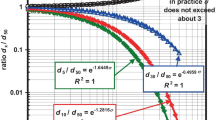Abstract
Traditional measures of sediment size (mean, sorting, skewness, etc.) contain less information than the original weightpercent histogram from which they are computed. For purposes such as mapping, summary statistics are necessary, but little is known of the relative efficiency of traditional measures. By multivariate methods, the relative efficiency of sediment-size descriptors may be analyzed and sediment distribution patterns may be investigated, utilizing the histogram directly. The statistic most efficient for classification of sediments is one which is least variable within a sediment type and most variable between types. The statistic most useful from a practical standpoint is one that strikes a balance between ease of measurement and any resulting loss in efficiency. Principal components analysis of sediment-size data from Barataria Bay, Louisiana, suggests that the first principal component is as efficient as any traditional statistic, and can be approximated with no loss in efficiency by the sand percent in samples. Analyses of variance show that the sand percent is the most efficient as well as the most useful statistic for characterizing Barataria sediments. Only one sieve separation is necessary to obtain essentially the same information as obtained from more laborious traditional analytical techniques.
Similar content being viewed by others
References
Guenther, W. C., 1964, Analysis of variance: Prentice Hall, Inc., Englewood Cliffs, New Jersey, 199 p.
Klovan, J. E., 1966, The use of factor analysis in determining depositional environments from grain-size distributions: Jour. Sed. Pet., v. 36, no. 1, p. 115–125.
Krumbein, W. C., and Aberdeen, E., 1937, The sediments of Barataria Bay: Jour. Sed. Pet., v. 7, no. 1, p. 3–17.
Spencer, D. W., 1963, The interpretation of grain-size distribution curves of clastic sediments: Jour. Sed. Pet., v. 33, no. 1, p. 180–190.
Wahlstedt, W. J., and Davis, J. C., 1968,fortran iv program for computation and display of principal components: Kansas Geol. Survey Computer Contr. 21, 27 p.
Author information
Authors and Affiliations
Rights and permissions
About this article
Cite this article
Davis, J.C. Information contained in sediment-size analyses. Mathematical Geology 2, 105–112 (1970). https://doi.org/10.1007/BF02315152
Received:
Issue Date:
DOI: https://doi.org/10.1007/BF02315152




